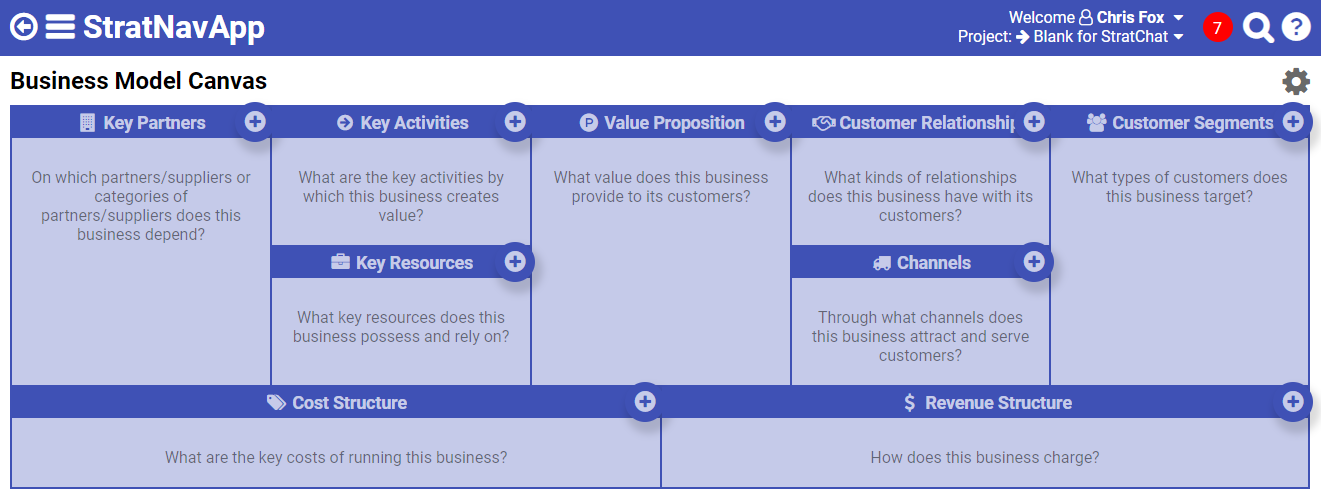 StratChat is a weekly virtual networking event for business strategists and anyone with an interest in developing and executing better business strategies. It is an informal community-led conversation hosted by StratNavApp.com. To sign up for future events click here.
StratChat is a weekly virtual networking event for business strategists and anyone with an interest in developing and executing better business strategies. It is an informal community-led conversation hosted by StratNavApp.com. To sign up for future events click here.
StratChat is conducted under Chatham House Rules. Consequently, the summary below is presented without any attribution of who said what. As such, they are an agglomerate of views - not necessarily just those of the writer or indeed of any one individual.
This week's conversation focused on the Business Model Canvas, its variants and uses.
 Origins of the Business Model Canvas
Origins of the Business Model Canvas
The Business Model Canvas was first presented in the book Business Model Generation by Alex Osterwalder and Yves Pigneur. It was originally proposed as a tool to enable innovators to develop (often multiple) business models for an idea from which they could develop and test hypotheses before deciding to proceed or not.
This work also spawned the idea that, in future, businesses will compete on the basis of busing models, not products and services.
However, it can also be used as a descriptive and diagnostic tool for almost any type of business. This is because it helps to create a holistic picture of the business (as opposed to a marketing, engineering, financial, etc. perspective of the business).
 Variations of the Business Model Canvas
Variations of the Business Model Canvas
The Enhanced Business Model Canvas was introduced by Andrew Campbell et al in their book Operating Model Canvas. It replaces the left-upper area of the Business Model Canvas with an Operating Model Canvas. The differences are subtle but not insignificant. The Enhanced Business Mode Canvas is perhaps more suited to more established and/or traditional businesses, whilst the original Business Model Canvas was more targeted at startups or specific innovations.
The Lean Canvas is even more focused on startups than the original Business Model Canvas. It is more focused on identifying a clear problem to be solved, as well as alternative ways of solving it. It also includes space for identifying existing alternatives, metrics, and unfair advantages. None of these is explicitly represented in the Business Model Canvas.
The Value Proposition Canvas is a good companion to the Business Model Canvas. It breaks the Value Proposition and Customer elements out into more detail.
The Mission Model Canvas is a variant of the Business Model Canvas developed especially for not-for-profit (or mission-driven) organisations.
How to use them
One thing that all the canvas have in common is that they provide a standardised (once you've chosen which canvas to use!) framework for describing key elements of a business or business idea.
As a diagnostic tool, they provide a checklist of aspects of the business to understand and evaluate.
Practitioners can use these canvases to good effect without revealing that they are using them. In fact, sometimes revealing the framework too early can be distracting. People start to worry about how the canvas works, and less about the diagnostic process the practitioner is guiding them through.
The canvases also provide a great alternative to traditional business plans. Traditional business plans are often "25 pages of proforma nonsense".
Sometimes, business are forced to go through the traditional business plan process. Even here, the Business Model Canvas can help in the early stages to increase focus and identify risks.
A participant remembered having walked down a corridor in a large corporate. Two departments had each posted their performance data in the corridor. It was as if they were competing with each other. As a result, they had lost their focus on the organisation's strategy. The canvases are simple tools to remind us of what the strategy and business model are so that departments can remain focused on what is important.
Tools
Participants use a variety of tools for these purposes.
- StratNavApp.com includes the Business Model Canvas and Value Proposition Canvas (as well as the Lean Canvas and Enhanced Business Model Canvas)
- Strategyzer has tools for the Business Model Canvas and Value Proposition Canvas.
- Mural has a template for the Business Model Canvas.
- LivePlan allows you to prepare proforma business case numbers without being an Excel power user and can be used in conjunction with the Lean Canvas.
However, many organisations still use PowerPoint. This creates several problems:
- Important artefacts end up embedded in multiple versions of different PowerPoint decks in various people inboxes and other file storage systems. It becomes hard to keep track of which versions are the most up to date. Some organisations have teams who seem to do little beyond copying slides from one deck to another to ensure they are all up to date. Still we here stories of boards being shown out-dated copies of slides by accident.
- PowerPoint has no idea what the information it presents means. Any cross-referencing or cross-checking must therefore be done manually. It can easily become out of date and inaccurate.
The Business Model Canvas in more complex organisations
The Business Model Canvas is most obviously suited to simple, focused organisations which deliver a single product or service.
Can you shoehorn a more complex organisation into it? Perhaps an organisation which consists of six divisions, each providing a range of different products and services to different target markets? This is certainly non-trivial. The Business Model Canvas can be used to help to discern the essence of what binds such an organisation together.
Supporting the Balanced Scorecard
The Business Model Canvas is great for helping an organisation to develop a Balanced Scorecard. Because it
- provides a more holistic view of the organisation,
- helps to consider how operations deliver the customer value proposition, and
- highlights the key cost and revenue consequences of the above
it helps to draw out the goals, objectives and key performance indicators across the financial, customer and internal business process perspectives of the Balanced Scorecard.
Also, because a diagnostic process conducted using a Business Model Canvas will help to identify what needs to change in all of those areas, it will help to identify both leading and lagging indicators. This will further increase the balance in a scorecard.
For discussion next week
After a short discussion we decided that the next StratChat will look at: why is it that sometimes, even the most well-formulated strategies don't get executed?
Why not join us for what should be another fascinating discussion? You can find out more and sign up here.
Attendees: Chris Fox (host and notetaker), Jerald Welch, Pratap Lakshmanan and Zubair Naseer.
